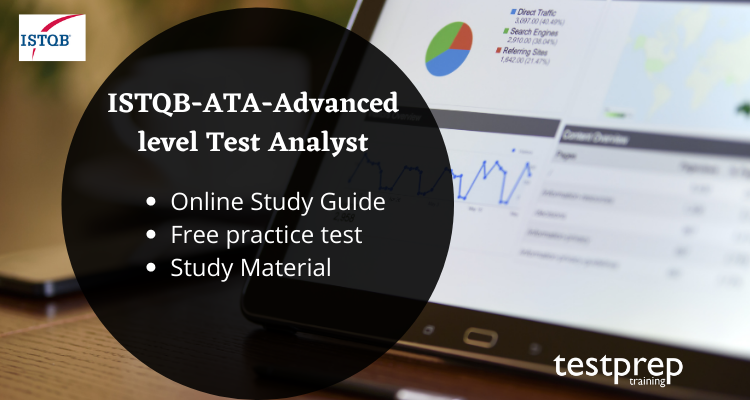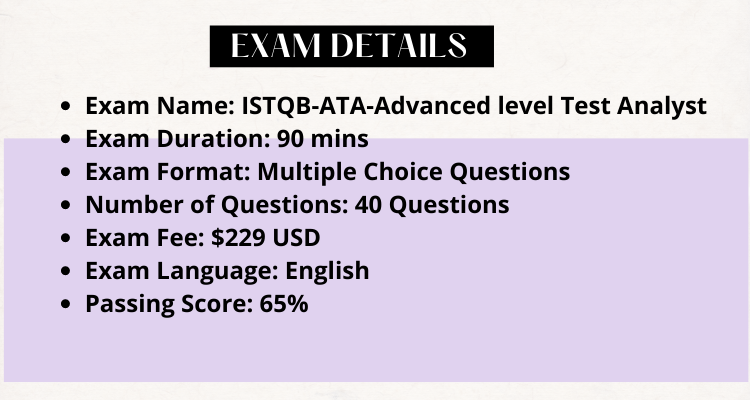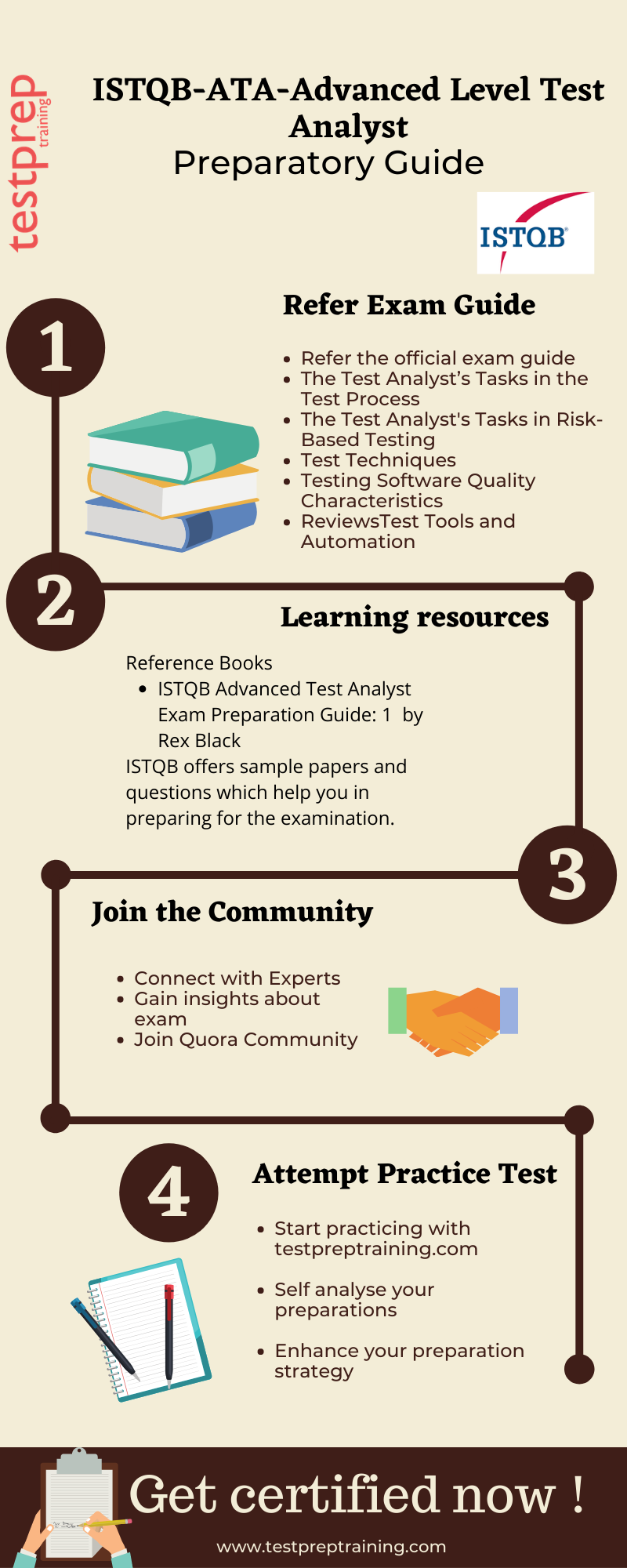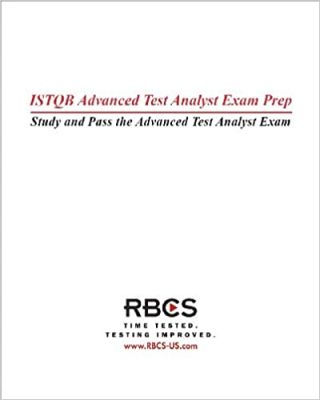ISTQB-ATA-Advanced level Test Analyst

The ISTQB-ATA-Advanced level Test Analyst examination is designed to analyze and summarize the appropriate tasks for the Test Analyst. It will help you in developing skills required in risk identification, perform risk assessment, and propose appropriate risk mitigation. This certification will defiantly help you grow in your analyst career.
Exam Prerequisites
The Certified Tester Foundation Level certificate shall be obtained before taking the Advanced Level Test Analyst certification exam
Skills Acquired
After completion of this examination you will develop and acquire the following skills:
- perform the appropriate testing activities based on the software development lifecycle being used;
- determine the proper prioritization of the testing activities based on the information provided by the risk analysis;
- select and apply appropriate test techniques to ensure that tests provide an adequate level of confidence, based on defined coverage criteria;
- provide the appropriate level of documentation relevant to their testing activities;
- determine the appropriate types of functional testing to be performed;
- work effectively in a usability testing team;
- effectively participate in requirements/user story reviews with stakeholders, applying knowledge of typical mistakes made in work products;
- improve the efficiency of the test process with the use of tools.
Learning Objectives
- Explain how and why the timing and level of involvement for the Test Analyst vary when working with different software development lifecycle models.
- Summarize the appropriate tasks for the Test Analyst when conducting analysis and design activities.
- Explain why test conditions should be understood by the stakeholders.
- For a given project scenario, select the appropriate design level for test cases (high-level or low-level).
- Explain the issues to be considered in the test case design.
- Summarize the appropriate tasks for the Test Analyst when conducting test implementation activities.
- Summarize the appropriate tasks for the Test Analyst when conducting test execution activities.
- For a given situation, participate in risk identification, perform a risk assessment and propose appropriate risk mitigation.
- Analyze a given specification item(s) and design test cases by applying equivalence partitioning.
- Analyze a given specification item(s) and design test cases by applying boundary value analysis.
- Analyze a given specification item(s) and design test cases by applying decision table testing.
- Analyze a given specification item(s) and design test cases by applying state transition testing.
- Explain how classification tree diagrams support test techniques.
- Analyze a given specification item(s) and design test cases by applying pairwise testing.
- Analyze a system, or its requirement specification, in order to determine likely types of defects to be found and select the appropriate black-box test technique(s).
- Explain the principles of experience-based test techniques, and the benefits and drawbacks compared to black-box and defect-based test techniques.
- Determine exploratory tests from a given scenario.
- Describe the application of defect-based test techniques and differentiate their use from black-box test techniques.
- For a given project situation, determine which black-box or experience-based test techniques should be applied to achieve specific goals.
- Explain what test techniques are appropriate to test functional completeness, correctness and appropriateness.
- Define the typical defects to be targeted for the functional completeness, correctness and appropriateness characteristics.
- Define when the functional completeness, correctness and appropriateness characteristics should be tested in the software development lifecycle.
- Explain the approaches that would be suitable to verify and validate both the implementation of the usability requirements and the fulfillment of the user’s expectations.
- Explain the role of the test analyst in interoperability testing including identification of the defects to be targeted.
- Explain the role of the test analyst in portability testing including identification of the defects to be targeted.
- For a given set of requirements, determine the test conditions required to verify the functional and/or non-functional quality characteristics within the scope of the Test Analyst.
- Identify problems in a requirements specification according to checklist information provided in the syllabus.
- Identify problems in a user story according to checklist information provided in the syllabus.
- For a given scenario, determine the appropriate activities for a Test Analyst in a keyword-driven automation project.
- Explain the usage and types of test tools applied in test design, test data preparation, and test execution.
Exam Details
For the ISTQB-ATA-Advanced level Test Analyst examination you are given 90 minutes to complete the examination. Talking about the ISTQB Advanced Level Test Analyst exam questions, there will be 40 questions. Also, this ISTQB Advanced Level Test Analyst exam fee is $229. To add on, the exam rescheduling fee is $90. Also, you need to get at least 65% to pass the examination.

Exam Registration
For registering yourself for the examination, follow the following steps:
- Go on the official website of the ISTQB-ATA-Advanced level Test Analyst.
- Click on the register now an option
- You will be redirected to a registration page. Click on the option and follow the prompt.
- Make the payment and complete the registration.
Course Outline
The ISTQB Advanced Level Test Analyst syllabus covers the following topics:
The Test Analyst’s Tasks in the Test Process
- Introduction
- Testing in the Software Development Lifecycle
- TA-1.2.1 (K2) Explain how and why the timing and level of involvement for the Test Analyst varies when working with different software development lifecycle models
- Test Analysis
- TA-1.3.1 (K2) Summarize the appropriate tasks for the Test Analyst when conducting analysis activities
- Test Design
- TA-1.4.1 (K2) Explain why test conditions should be understood by the stakeholders
- TA-1.4.2 (K4) For a given project scenario, select the appropriate design level for test cases (high level or low-level)
- TA-1.4.3 (K2) Explain the issues to be considered in test case design
- Test Implementation
- TA-1.5.1 (K2) Summarize the appropriate tasks for the Test Analyst when conducting test implementation activities
- Test Execution
- TA-1.6.1 (K2) Summarize the appropriate tasks for the Test Analyst when conducting test execution activities
The Test Analyst’s Tasks in Risk-Based Testing
- The Test Analyst’s Tasks in Risk-Based Testing
- TA-2.1.1 (K3) For a given situation, participate in risk identification, perform a risk assessment and propose appropriate risk mitigation
Test Techniques
- Introduction
- Black-Box Test Techniques
- TA-3.2.1 (K4) Analyze a given specification item(s) and design test cases by applying equivalence partitioning
- TA-3.2.2 (K4) Analyze a given specification item(s) and design test cases by applying boundary value analysis
- TA-3.2.3 (K4) Analyze a given specification item(s) and design test cases by applying decision table testing
- TA-3.2.4 (K4) Analyze a given specification item(s) and design test cases by applying state transition testing
- TA-3.2.5 (K2) Explain how classification tree diagrams support test techniques
- TA-3.2.6 (K4) Analyze a given specification item(s) and design test cases by applying pairwise testing
- TA-3.2.7 (K4) Analyze a given specification item(s) and design test cases by applying use case testing
- TA-3.2.8 (K4) Analyze a system, or its requirement specification, in order to determine likely types of defects to be found and select the appropriate black-box test technique(s)
- Experience-Based Test Techniques
- TA-3.3.1 (K2) Explain the principles of experience-based test techniques and the benefits and drawbacks compared to black-box and defect-based test techniques
- TA-3.3.2 (K3) Identify exploratory tests from a given scenario
- TA-3.3.3 (K2) Describe the application of defect-based test techniques and differentiate their use from black-box test techniques
- Applying the Most Appropriate Test Techniques
- TA-3.4.1 (K4) For a given project situation, determine which black-box or experience-based test techniques should be applied to achieve specific goals.
Testing Software Quality Characteristics
- Introduction
- Quality Characteristics for Business Domain Testing
- TA-4.2.1 (K2) Explain what test techniques are appropriate to test the functional completeness, correctness and appropriateness
- TA-4.2.2 (K2) Define the typical defects to be targeted for the functional completeness, correctness and appropriateness characteristics
- TA-4.2.3 (K2) Define when the functional completeness, correctness and appropriateness characteristics should be tested in the software development lifecycle
- TA-4.2.4 (K2) Explain the approaches that would be suitable to verify and validate both the implementation of the usability requirements and the fulfillment of the user’s expectations
- TA-4.2.5 (K2) Explain the role of the Test Analyst in interoperability testing including identification of the defects to be target
- TA-4.2.6 (K2) Explain the role of the Test Analyst in portability testing including identification of the defects to be target
- TA-4.2.7 (K4) For a given set of requirements, determine the test conditions required to verify the functional and/or non-functional quality characteristics within the scope of the Test Analyst
Reviews
- Introduction
- Using Checklists in Reviews
- TA-5.2.1 (K3) Identify problems in a requirements specification according to checklist information provided in the syllabus
- TA-5.2.2 (K3) Identify problems in a user story according to checklist information provided in the syllabus
Test Tools and Automation
- Introduction
- Keyword-Driven Automation
- TA-6.2.1 (K3) For a given scenario determine the appropriate activities for a Test Analyst in a keyword-driven automation project
- Types of Test Tools
- TA-6.3.1 (K2) Explain the usage and types of test tools applied in test design, test data preparation and test execution
For more information, click on ISTQB-ATA-Advanced level Test Analyst FAQ.
Preparatory Guide for ISTQB-ATA-Advanced level Test Analyst
For the ISTQB-ATA-Advanced level Test Analyst examination, you will need proper guidance to succeed in the examination. However, to ease your preparation we have curated an ISTQB Advanced Test Analyst study guide specially designed by our experts.

Refer the Exam Guide
Since you are starting your preparation, however, you need to gather the ISTQB Advanced Level Test Analyst study material, course outline, and structure. To help you out we have given the list of topics that you are required to study for the ISTQB-ATA-Advanced level Test Analyst examination.
- The Test Analyst’s Tasks in the Test Process
- The Test Analyst’s Tasks in Risk-Based Testing
- Test Techniques
- Testing Software Quality Characteristics
- Reviews
- Test Tools and Automation

Learning Resources
For the ISTQB-ATA-Advanced level Test Analyst examination you will find lots of study material over the internet, however, deciding the right study material is a tedious task. Therefore, to help you out we have provided you with the ISTQB Advanced Level Test Analyst book that you can refer to while preparing. Also, ISTQB offers sample papers and questions which help you in preparing for the examination.
- ISTQB Advanced Test Analyst Exam Preparation Guide: 1 by Rex Black
Join Study Groups
It is very important to interact with people who have a common aim in life. Joining study groups is a good way to get yourself fully engage with the certification exam you applied for. These groups will help you get up to date with the latest changes or any update happening exam. Also, these groups contain both beginners as well as professionals. Also, you will be able to gain extra knowledge.
Practice with testpreptraining
It is very important to practice what you have learned so that you are in a position to analyze your practice, by practicing you will be able to improve your answering skills that will result in saving a lot of time. Moreover, the best way to start doing the ISTQB Advanced Test Analyst practice test is after completing one full topic as this will work as a revision part for you. Start practicing now!


